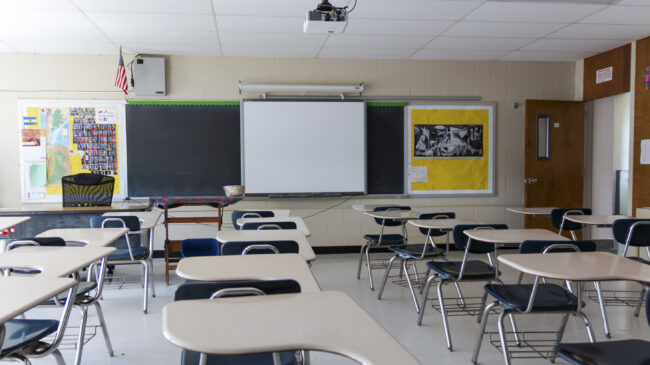K-12 public schools lost more than 1.1 million students from the spring of 2020 to the spring of 2022.
New data from Burbio, a service aggregating school enrollment and budget data, sheds light on how public school K-12 enrollments have fluctuated this school year (2022-23) in 15 states. Of the states reported, Burbio revealed that South Carolina (1.0% increase in K-12 students), North Dakota (1.3%), Massachusetts (0.2%), Utah (0.1%), Delaware (0.4%), Arkansas (0.6%), Georgia (0.6%), and Virginia (0.9%) experienced enrollment growth, while Indiana (-0.1% decrease in K-12 students), West Virginia (-0.3%), Wyoming (-0.4%), Mississippi (-0.5%), Idaho (-0.8%), Rhode Island (-0.8%) and Hawaii (-1.7%) saw enrollment drops.
- Interestingly, Idaho’s public school enrollment growth of 1.8% from the 2021-22 school year was partly reversed with the state’s 0.8% decline this year.
- Similarly, Wyoming experienced 7% enrollment growth between 2002 and 2020 but also saw student counts drop by 0.4% this year.
While most states have yet to announce their final enrollments for the start of the 2022-23 school year, preliminary reports from some large school districts may provide a sneak peek at trends.
- Recently, Minneapolis Public Schools reported it experienced a 2% decline in enrollment, and the school district’s finance committee announced an “impending financial crisis” due to the loss of students and expiring federal funds.
- Chicago Public Schools reported its K-12 enrollment dropped by 3% this fall.
- And New York City Public Schools reported a 1.8% decline in K-12 enrollment.
On the other hand, Arizona’s Department of Education announced in a preliminary report that the state’s K-12 public school enrollment has increased by 3.5% this school year.
Last school year, the states that experienced the largest declines in K-12 public school enrollment were New York (-2%) and California (-1.8%). K-12 enrollments still grew in about half of 50 states last year, with Montana, Idaho, Arizona, and South Carolina seeing the largest student growth in percentage terms. The net loss of public school students across the country was 91,000 students during the 2021-2022 year.
School districts grappling with changing enrollments must prepare for the fiscal consequences of fewer students, especially as federal emergency relief funds dry up. These factors mean that districts should do everything possible to prepare for slimmer budgets. Shortsighted spending decisions could have significant financial repercussions for school districts. Accordingly, school districts should shore up their budgets by rightsizing and using any remaining Elementary and Secondary School Emergency Relief Fund (ESSER) dollars on temporary commitments.
From the states
State legislators have already pre-filed various school choice proposals across the nation.
In Missouri, Rep. Josh Hulbert pre-filed five proposals advancing education savings accounts, one of which is a universal school choice bill that would expand the state’s current MOScholars program to be open to all students.
Two Texas legislators pre-filed proposals that would establish tax-credit education savings accounts. Under the proposals, parents could use these versatile accounts to pay for a variety of educational expenses, such as tutoring or private school tuition.
Ohio legislators are considering a proposal that would expand eligibility for the state’s voucher program to all students regardless of their household income. The proposal also aims to increase the existing income tax credit for homeschooling expenses from $250 to $2,000 a year.
In Tennessee, legislators are considering a proposal that would expand school district eligibility to participate in the Volunteer State’s education savings account program. Current law limits participation to school districts with 10 schools that performed in the bottom 10%, whereas the proposal would allow school districts with five or more schools that performed in the bottom 10% to be eligible.
What to watch
Kentucky Supreme Court Rules Tax-Credit ESA Unconstitutional
The Kentucky Supreme Court unanimously ruled that Kentucky’s Education Opportunity Account Program violated the state’s constitution. These accounts allowed eligible parents to use money donated to account-granting organizations to pay for education expenses, such as private school tuition, tutoring, transportation, and more. Individuals that donated to an account-granting organization would receive a tax credit. The court wrote, “If the legislature thinks the people of Kentucky want this change, [it] should place the matter on the ballot.”
Teachers’ Union Sues New Hampshire DOE Over Education Freedom Accounts
The New Hampshire arm of the American Federation for Teachers is suing the New Hampshire Department of Education over the agency’s Education Freedom Accounts–education savings accounts available to students in low or middle-income households. Account holders can use them to pay for a variety of educational expenses, such as private school tuition, tutoring, and books. More than 3,000 students currently have an Education Freedom Account. The Institute for Justice, which successfully defended the Granite State’s tax-credit scholarship program in 2014, will represent Education Freedom Account holders.
Vermont Must Now Pay for Private School Tuition Under the Town Tuition Program
A recent settlement in the wake of Carson v Makin ended discrimination against religious private schools in Vermont. The Green Mountain State’s Town Tuition Program required towns to pay for the private education of any student that resided in a town without a public school. However, towns were not required to reimburse eligible families that enrolled their children in religious private schools. Not only did the recent settlement deem this policy unconstitutional, but the Vermont Education Agency also issued a letter to school districts requiring them to treat private religious schools the same as secular ones.
Oklahoma to Open the Nation’s First Religious Charter School
The Oklahoma Attorney General released an opinion that prohibitions against religious charter schools are unconstitutional in the wake of recent Supreme Court decisions. The Archdiocese of Oklahoma City plans to submit an application for a virtual charter school authorization. If approved, this would be the nation’s first religious charter school. However, the religious charter school would likely face legal challenges from the Freedom from Religion Foundation.
Recommended reading
Rerouting the Myths of Rural Education Choice
Ron Matus and Dava Hankerson at Step Up for Students
“Families in rural Florida, like families everywhere, are choosing learning options other than district schools. In 2021-22, 16.7 percent of students in Florida’s 30 rural counties attended something other than a district school, whether a private school, charter school or home education. That’s up from 10.6 percent a decade prior.”
ICYMI: How is the new transfer law affecting schools? It depends on which districts you ask
Andrea Eger at Tulsa World
“We’ve always lived on a lot of transfers, and I think we’re a well-kept secret,” said Superintendent Sherry Durkee, whose district has seen a 23% increase in transfer students compared with last year’s numbers. “There has been a big change in expectations with people wanting versatility to access education like they want it. We have made a concerted effort to maximize choice within the district because we have to get on board with the way of the future.”
The Ohio EdChoice Program’s impact on school district enrollments, finances, and academics
Stéphane Lavertu and John J. Gregg at Fordham Institute
“The analysis indicates that the performance-based EdChoice program led to lower levels of segregation among minority students, no change (and perhaps an increase) in district expenditures per pupil, no change in districts’ ability to generate local revenue (leading to an increase in local revenue per pupil), and higher academic achievement among the remaining district students.”

